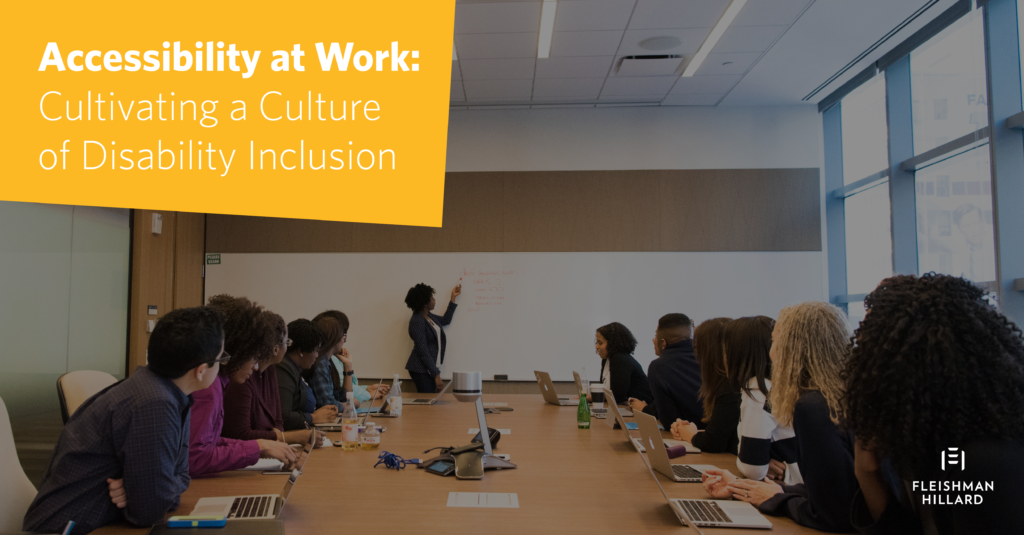Accessibility at Work: Cultivating a Culture of Disability Inclusion
Over the past decade, many industries have begun creating products and services from an “accessibility-first” perspective: one that considers the needs of as many people as possible from the start. This approach prioritizes equitable experiences for users, including the estimated 1.2 billion persons with disabilities across the world. As communications practitioners, it is vital to ensure that materials are designed with a diverse audience in mind.
However, to cultivate a true culture of accessibility, we must not merely consider the impact of products and services on users. We must push beyond what we create to look at who we are as creators to open meaningful dialogues concerning our own workplace environments. When communications departments fail to maintain a culture that respects and values people with disabilities, this fails us all.
Here are three ways we can all support a culture of disability inclusion in the workplace:
Ramp up disability inclusion education
The path to creating an accessible environment for individuals with disabilities begins with developing a workplace culture that is founded in and actively practices inclusive values. Through top-down promotion of accessibility education, all employees can gain deeper insight into the experiences and needs of others.
Training and education practices need not be limited to official seminars or mandated online programs. Initiatives such as creating inclusive language and design guides and inviting speakers on disability and accessibility topics can enrich both the work we create and those who create it. Other activities like holding brainstorm sessions, with the intent to identify strategies to counteract disability biases, also support active learning.
Additionally, partnerships and collaborations offer valuable opportunities to support accessibility education and development. FleishmanHillard’s membership within The Valuable 500 – a network of companies committed to supporting disability inclusion – strengthens our capacity to develop and act upon accessible strategies within business.
Overall, educational programs and strategies must emphasize appropriate workplace behavior, how to uphold core accessible values in business and the process for reporting behavior that violates these values.
Promote accessible hiring practices
Creating an inclusive recruitment program requires consistent actions to combat hiring biases and proactively include those with disabilities. While inclusive hiring is founded in the domain of human resources professionals, it is ultimately a collaborative effort.
First, accessible job descriptions are a must. The language used within these descriptions reflect the values of the hiring organization and informs the applicant’s perception of the workplace culture. Where possible, communications professionals must advocate for up-to-date disability inclusion statements and accessible language in the role description. These should be regularly reviewed and revised as language conventions evolve.
Additionally, practices such as posting positions on job boards or attending career fairs that specifically support people with disabilities facilitates equitable recruitment. Furthermore, ensuring hiring teams are comprised of people with diverse identities and perspectives introduces a higher level of objectivity into this process. Communications professionals should use their position within a hiring team to actively support accessible practices, to the extent possible given their role within an organization.
As an example of such efforts, FleishmanHillard has partnered with the International Paralympic Committee and other Omnicom agencies to launch #WeThe15 – a decade long campaign that aims to further access to core human rights such as employment, education and healthcare for the 15% of the world with disabilities. An active commitment to disability inclusion during hiring is a critical part of breaking down barriers that people with disabilities face.
Establish and support employee resource groups
Everyone deserves a space where they feel heard and respected for their most authentic selves. Employee Resource Groups (ERGs) are voluntary groups, created with the purpose of supporting an inclusive environment, comprised of and led by employees who share a common identity or who are allies.
People with disabilities can form connections with individuals across entire organizations that may not otherwise be organically developed. These connections foster a sense of belonging within the workplace and bolsters employees’ ability to create diverse, groundbreaking work through collaborations.
At FleishmanHillard, our DisAbility Community ERG creates a space for people with disabilities and allies to find support and engage in open communication. Through enabling productive discussion about inclusive practices and the lived experiences of people with disabilities, this group has a unique and active impact on our communications work.
Conclusion
Each of these steps bring us closer to creating a culture of accessibility. However, at FleishmanHillard, we recognize the need to continuously improve and adapt our strategies on the path to inclusion. Through regular review and dialogues concerning these practices, communications professionals can foster disability inclusion around the world.

